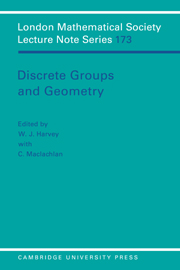Book contents
- Frontmatter
- Contents
- Preface
- Symmetries of modular surfaces
- Lifting group actions to covering spaces
- A combinatorial approach to the symmetries of M and M–l Riemann surfaces
- Inequalities for Pell equations and Fuchsian groups
- The Euler characteristic of graph products and of Coxeter groups
- Infinite families of automorphism groups of Riemann surfaces
- Planar hyperelliptic Klein surfaces and fundamental regions of NEC groups
- An example of an infinite group
- Moduli of Riemann surfaces with symmetry
- Modular groups – geometry and physics
- On automorphisms of free products
- The growth series of the Gieseking group
- Exceptional representations of PSL2(q) of monodromy genus zero
- On the rank of NEC groups
- The geometry of bending quasi-Fuchsian groups
- Farey series and sums of continued fractions
- Commensurability classes of two-generator Fuchsian groups
- Limit points via Schottky pairings
- Diagonalizing Eisenstein series III
- Some remarks on 2-generator hyperbolic 3-manifolds
- Uniformization, graded Riemann surfaces and supersymmetry
- Generating sets for finite groups
- Group actions on trees with and without fixed points
Some remarks on 2-generator hyperbolic 3-manifolds
Published online by Cambridge University Press: 10 December 2009
- Frontmatter
- Contents
- Preface
- Symmetries of modular surfaces
- Lifting group actions to covering spaces
- A combinatorial approach to the symmetries of M and M–l Riemann surfaces
- Inequalities for Pell equations and Fuchsian groups
- The Euler characteristic of graph products and of Coxeter groups
- Infinite families of automorphism groups of Riemann surfaces
- Planar hyperelliptic Klein surfaces and fundamental regions of NEC groups
- An example of an infinite group
- Moduli of Riemann surfaces with symmetry
- Modular groups – geometry and physics
- On automorphisms of free products
- The growth series of the Gieseking group
- Exceptional representations of PSL2(q) of monodromy genus zero
- On the rank of NEC groups
- The geometry of bending quasi-Fuchsian groups
- Farey series and sums of continued fractions
- Commensurability classes of two-generator Fuchsian groups
- Limit points via Schottky pairings
- Diagonalizing Eisenstein series III
- Some remarks on 2-generator hyperbolic 3-manifolds
- Uniformization, graded Riemann surfaces and supersymmetry
- Generating sets for finite groups
- Group actions on trees with and without fixed points
Summary
Introduction
By a hyperbolic 3-manifold we shall always mean a complete orientable hyperbolic 3-manifold of finite volume. A hyperbolic 3-manifold M is said to be n-generator if the minimal number of elements required to generate π1(M) is n. The focus of this paper is 2-generator hyperbolic 3-manifolds, the main aim being to give a construction of infinitely many closed hyperbolic 3-manifolds which are not 2-generator, but have a proper finite cover which is. Our interest in such examples was motivated by the deep results contained in [4] and [10] which relate questions on 2-generator subgroups of hyperbolic 3-manifold groups to estimates on the lower bound for the smallest volume of a closed hyperbolic 3-manifold. We also construct certain 2-generator Haken hyperbolic 3-manifolds whose existence helps to explain why more recent methods of Culler and Shalen (in preparation) seem to be necessary for estimating volumes of closed Haken hyperbolic 3-manifolds.
To describe the connection between the articles referred to above and the contents of this article we need to recall the definition of a Margulis number of a hyperbolic 3-manifold.
Let M = H/Γ be a closed hyperbolic 3-manifold and ò > 0. Then ò is a Margulis number for M if for every point z of H and every pair of noncommuting elements γ and δ of Γ we have max{ξ(z,γ(z)),ξ(z,δ(z))} ≥ ò, where ξ denotes the hyperbolic metric.
- Type
- Chapter
- Information
- Discrete Groups and Geometry , pp. 209 - 219Publisher: Cambridge University PressPrint publication year: 1992
- 1
- Cited by

